|
living:
feature
 Releasing from Bondage, as the Bond girls find feminism Releasing from Bondage, as the Bond girls find feminism
The cinematic “Bond girls”
have tended to be male fantasies, but has feminism finally been
found with the Daniel Craig-era James Bond films? Jack Yan
wonders
photographs from Quantum of Solace by Karen Ballard
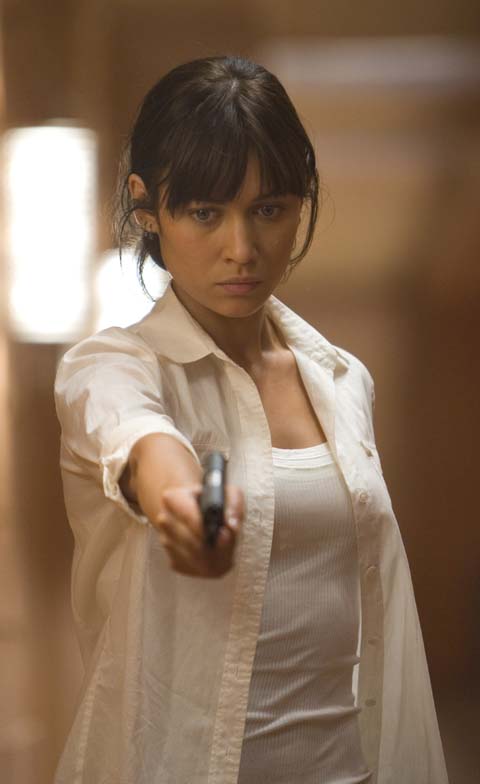
Ukranian actress Olga Kurylenko as Camille, taking matters into
her own hands, in the MGM–Columbia film Quantum of Solace.
PHOTO: KAREN BALLARD
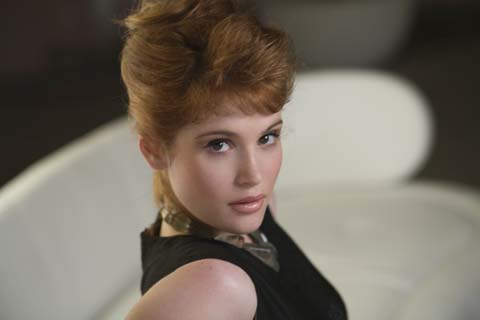
Gemma Arterton, the second Bond girl in Quantum of Solace,
playing MI6 agent Strawberry Fields. A new type of Bond girl, or
(below) a throwback to the old—set in the honeymoon
suite of the Andean Grand Hotel, Bolivia? PHOTOS:
KAREN BALLARD

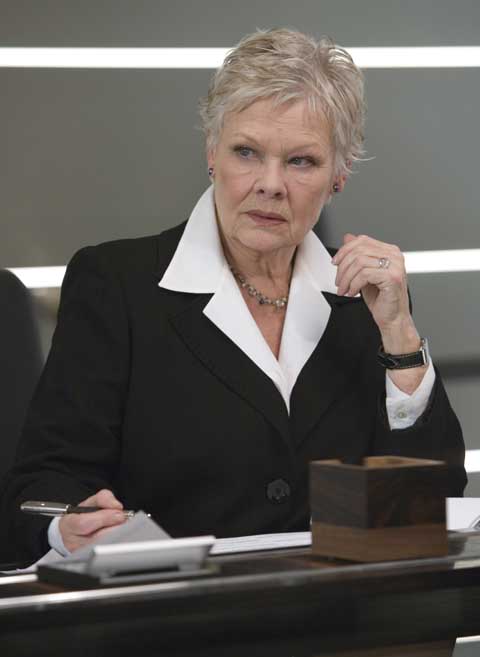
Dame Judi Dench as M, pictured in her office—the first sign,
in 1995, that the Bond films had changed their tune about their
sexism. PHOTO: KAREN
BALLARD
Bond has his suits, his Swiss watch, his Walther
pistol and his Aston Martin, but the women are now as difficult
to conquer or even understand for him as they are to mere mortal
men
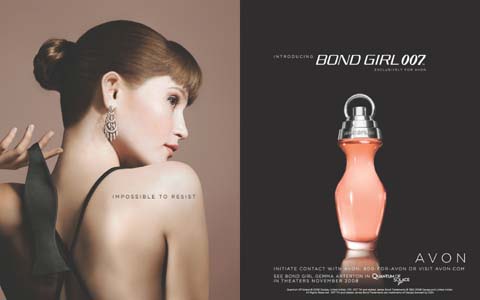
Avon’s Bond Girl 007 fragrance as endorsed by Arterton: a sign
of independence, or another product that asks women to be seen through
male eyes?
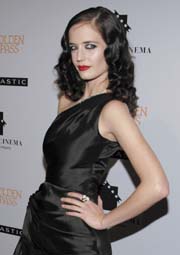 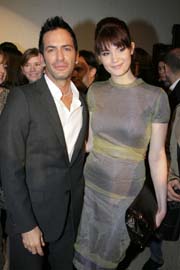
Far left: Eva Green, the third actress to
play Vesper Lynd on screen, at the première of The Golden
Compass. Left: New Bond girl Gemma Arterton, with Marc
Jacobs at a Louis Vuitton show.
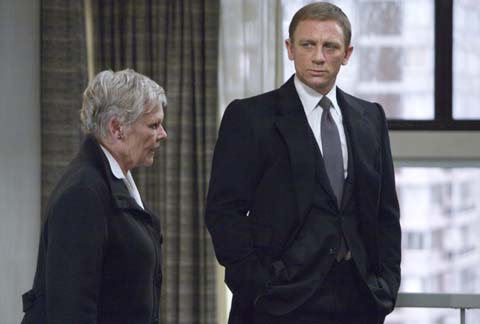
M (Dame Judi Dench) and James Bond (Daniel Craig) enter Mitchell’s
apartment, a scene from Quantum of Solace. PHOTO:
KAREN BALLARD
Quantum of Solace opens Friday in the UK and November 14
in the US.
|
IF YOU WATCH the interviews in various
behind-the-scenes extras included with the James Bond DVDs,
there are frequent comments from many of the leading ladies—Bond
girls, for want of a better term—on how their character is ‘different’.
They are Bond’s equals, sometimes counterparts, to Bond.
These extras were originally promotional TV
programmes, getting potential moviegoers excited about the next
Bond, and the audience would then go along wondering just how the
new Bond woman would be different from the damsel in distress. Jane
Seymour’s screaming, one-lover Solitaire was a prime, helpless example
in 1973’s Live and Let Die, as Bond has to rescue her from
a voodoo ceremony; but visits to the cinema over decades reveal
that the typical Bond girl is hardly the independent post-feminist-movement
character their actresses promise.
Diana Rigg, the ill-fated Mrs Bond in 1969’s On
Her Majesty’s Secret Service, is often held up as the zenith
of the Bond women, partly because of the way Peter Hunt directed
her, and partly because of her prior reputation as a high-kicking
heroine in The Avengers. It becomes somewhat sad when Maryam
d’Abo, of 1987’s The Living Daylights, promised in her pre-release
interview that hers was a modern Bond woman and that her own preference
was Rigg, when she was a cellist who screamed (thankfully) less
than Seymour for 007 to rescue her. It is hardly the fault of d’Abo,
but even in the 1980s, the Bond woman falls into the realm of the
male fantasies of submission and conquest.
Barbara Broccoli, the producer of the Bond films
and the daughter of the original producer who brought 007 to the
big screen, says that in fact the Bond girls are ‘feminist icons’.
Pussy Galore, she points out, could fly planes; but then, Pussy
Galore was a lesbian who goes straight after a snog in a barn from
(and presumably sex with) Bond, at least in the film version where
her homosexuality is far from apparent.
Broccoli told The Sunday Telegraph that
the early Bond girls were ‘progressive’ and some were ‘sexual predators’,
and there is some truth to it. Fiona Volpe, played by Luciana Paluzzi
in Thunderball, even points out to Connery’s Bond that despite
their love-making she will not turn to the side of good, but she
stands out more as an exception than the rule.
The early films can be defended more readily:
Broccoli’s father, the famed Albert R. ‘Cubby’ Broccoli, and partner
Harry Saltzman would never have made Bond a success without following
some mainstream thoughts, and pushing (at least for the 1960s) the
envelope as far as sexuality was concerned. Ursula Andress’s bikinied
Honey Rider in Dr No, the brief glimpse of a naked actress
in From Russia with Love (Daniela Bianchi, who played Tania
Romanova, has denied it was her), the gold-painted figure of Shirley
Eaton in Goldfinger all titillated audiences in the ’60s.
And that was a lot of it: titillation. The double-entendres
of Aki’s ‘I would very much enjoy serving under you,’ uttered to
Bond in Roald Dahl’s screenplay of You Only Live Twice, Bond’s
‘I’m on top of the problem’ to Tiffany Case in Diamonds Are Forever
and, worst of all, ‘I think he’s attempting re-entry’ in Moonraker
became so commonplace in what Pierce Brosnan called ‘the high jinks
of Bond’ that it proved to be fertile ground for Mike Myers and
the Austin Powers films (and, many decades before, the Columbia
Pictures’ adaptations of the Matt Helm books, James Coburn as Derek
Flint, and the second attempt in 1967 at Bond creator Ian Fleming’s
Casino Royale novel).
Ironically, by the 1970s, with the feminist movement
having gained more momentum, the Bond women suffered from a lack
of depth, being caricatures. Barbara Bach’s Major Anya Amasova,
a.k.a. Agent XXX (emphatically not
Vin Diesel) in 1977’s The Spy Who Loved Me may be remembered
more for her figure. Having vowed to kill Bond mid-way through the
film, she winds up sleeping with him prior to the end credits. Lois
Chiles, one actress to have appeared in Bond and in Austin Powers,
is a CIA agent with a Ph.D., but bearing
qualifications does not make her a particularly different Bond woman,
who still needs to be rescued by Roger Moore wearing a safari suit.
One could say that that was the 1970s: the Bond
money-making machine seemed to progress when the emphasis was high-camp
and escapist, and 1969’s attempt at humanizing Bond in On Her
Majesty’s Secret Service, with Australian George Lazenby in
the lead role, proved to be less successful than the other cinematic
outings. Depth was out, just as Lazenby was, and Bach happily reached
the peak of showing ’70s cleavage in the wake of Britt Ekland, playing
a doe-eyed bimbo in The Man with the Golden Gun. The trend
continued into the decade with jiggle TV
(Charlie’s Angels, Three’s Company), not necessarily started
by Bond, but certainly part of the Zeitgeist. Benny Hill’s
‘Angels’, decades before Victoria’s Secret’s ones, wore less and
less as the disco era reached its height. In all these cases, the
premise of showing independent women—or at least women in previously
stereotypically male roles—was a pretext for showing the 1960s’
submissive women in more garish fashions with more décolleté.
Even when the Bond women are given greater responsibilities—the
self-employed Octopussy, for example, running a diverse global empire—they
wind up following the formula. They can be initially abrasive and
emotionally tough—e.g. Carey Lowell’s Pam Bouvier in 1989’s Licence
to Kill, another CIA agent allied
with 007—and somehow the producers give the audience the same thing
by the end of the film. Bouvier is jealous of her rival, played
by Talisa Soto.
It didn’t get better the next decade. The Brosnan
era (1995–2002) saw the formula become even more cartoon-like with
Die Another Day, though redeemed in part with Michael Apted’s
The World Is Not Enough, where Elektra King (Sophie Marceau)—another
businesswoman in the Bond world—is proved to be a seductress who
decides when, where and with whom she has sex with. But then the
film has Denise Richards in it, a well endowed Bond girl with yet
another Ph.D., put in as a token nod to an American audience while
her co-stars are Irish, French, Scottish and English. Characters
such as Famke Janssen’s Xenia Onatopp, an assassin, in 1995’s Goldeneye
are two-dimensional, if relatively well acted.
Marceau is joined in this era only by Samantha
Bond, the last Miss Moneypenny, secretary to M, the head of the
Secret Service, who goes less ga-ga than her predecessors over the
arrival of and sexual harassment by 007 at the office.
So while the Bond women have equality as far as
their jobs are concerned—even Bond’s boss, M, is now female, played
by Dame Judi Dench—sexually, the first 40 years of films placed
the majority of them in objectified, submissive roles. Even PM
Margaret Thatcher (Janet Brown) in For Your Eyes Only begins
gushing at a parrot’s request to ‘Give us a kiss’
when she thinks it’s 007 over a radio telephone line.
Only a few exceptions in the first 40 years of
the cinematic Bond—Paluzzi, Rigg and Marceau; to some extent Carole
Bouquet in For Your Eyes Only who seduces Bond in the last
scene; and Barbara Carrera in the Thunderball remake, Never
Say Never Again (1983)—suggest that Bond women aren’t submissive,
swooning at the sight of the British spy. And to give credit where
it is due, since Barbara Broccoli has been producing, the female
characters are genuinely stronger.
Most may look the part of glam goddesses,
but then, not many men look like Bond. Model looks are part of the
escapism. Some might say the sexism is, too—but will the series
survive with it intact? Derek Flint might not survive in 2008, at
least not in the world of an actioner. He would have to be a comic
character.
With Daniel Craig in the role of James Bond for
2006’s Casino Royale, Broccoli and half-brother Michael G.
Wilson, who co-produces the films, promised fans that they would
return the series to the spirit of Fleming. The Bond girl, Vesper
Lynd, played by Franco–Swedish actress Eva Green, was promoted from
little more than an assistant in the novel to a representative of
HM Treasury, and fortunately she has
more depth than many other portrayals. She does not succumb to Bond’s
charms, even when Bond believes she has; in fact, 007 becomes emotionally
scarred both in the novel (with the famous last line, ‘The bitch
is dead’) and the film. Sex with Bond does not turn her from being
a traitor to Her Majesty’s Government either in the novel or the
film. For a woman created in the 1950s, Lynd seems more in tune
with the 2000s, far from the character’s previous portrayal—by Dr
No’s Andress—who seduces Peter Sellers’ Evelyn Tremble in 1967’s
Casino Royale.
Lynd’s depth is credited to the Oscar-winning
screenwriter of Crash, Paul Haggis, who worked on the first
screenplay by Neal Purvis and Robert Wade. Lynd and Bond grow fonder
of one another; they find pleasure with each other as their relationship
deepens.
It might be said that Fleming’s Bond women are
being translated to the screen more faithfully in some cases. The
literary Honey Rider used a spider to kill a man who attempted to
rape her; Pussy Galore was more a gangland boss in her own right
than a pilot. We may have finally reached an era where it is all
right to show complex women, nearly forty years after On Her
Majesty’s Secret Service, the one time before Casino Royale
where the director demanded that the screenplay be faithful to the
novel and bring emotion to Bond. This was financially concerning
then but a financial bonanza today in a more paranoid, post-9-11
fin de décennie. Bond has his suits, his Swiss watch,
his Walther pistol and his Aston Martin, but the women are now as
difficult to conquer or even understand for him as they are to mere
mortal men.
Olga Kurylenko and Gemma Arterton play the two
female leads in the latest Bond adventure, Quantum of Solace.
Haggis is again involved in the screenplay and the story continues
on from Casino Royale. (The original Quantum of Solace
story has little more than Bond at a dinner party initially being
frustrated by the other guests, then being told a story by the Governor of Jamaica about a couple’s broken marriage.) Arterton recently appeared in the Life on Mars-meets-Pride and Prejudice mini-series,
Lost in Austen, so she is hardly the bimbo type. Kurylenko’s
résumé includes L’Annulaire, which won her
the Certificate of Excellence as Best Actress at the 2005 Brooklyn
International Film Festival, and acclaim at the Toronto Film Festival.
Mathieu Amalric, the César-winning actor and director, plays
the villain. In short, it doesn’t appear to be another cartoony
Bond, which can only harm the franchise at this point if it is to
stay relevant in the 21st century.
Kurylenko’s character, Camille, is out for revenge
for the rape and murder of her sister and mother. She has said in
interviews that she exists in the script not because of Bond, but
because of her own character. Bond doesn’t bed her—they are intertwined
in the plot for personal revenge. But Arterton’s character, MI6
agent Fields, Strawberry Fields, seems more simplistic, if her name
is anything to go by.
Avon has finally deemed it appropriate to market
a Bond Girl 007 fragrance, something which some women might balk
at. Arterton is the face of the advertising. Is Fields the new type
of Bond woman, or is she the type that falls for Bond’s charms a
little too readily, like the literary Mary Goodnight? And is the
fragrance one chosen by women for women, or by women seeing themselves
objectified through male eyes?
Women, if an informal poll at Lucire is
indicative, liked the Vesper Lynd character, so the Sisterhood may
finally be getting its way after four-and-a-half decades of putting
up with male fantasies. Camille shows that Vesper was no lucky one-off.
Fields shows that not everything has changed and that the same speculation
must exist for “Bond 23” on whether the next film
will have a realistic female lead or something more formulaic. •
Add
to Del.icio.us | Digg
it | Add
to Facebook
Add public feedback on our blog
|

